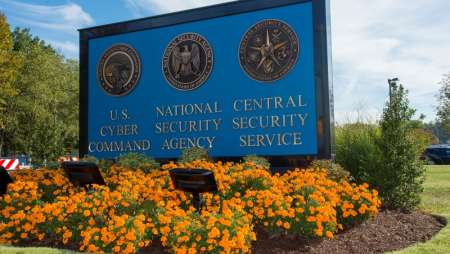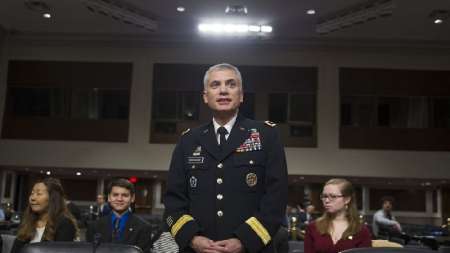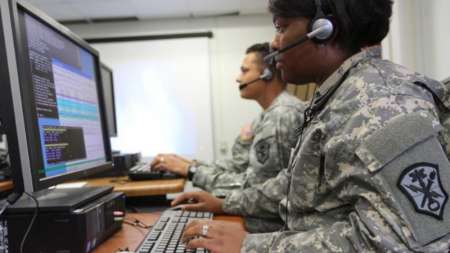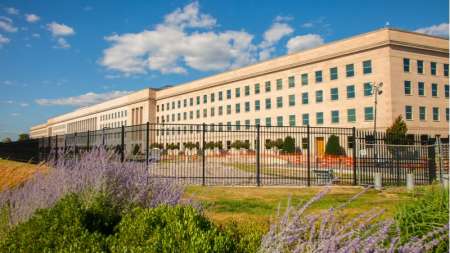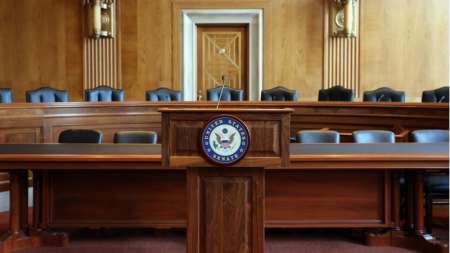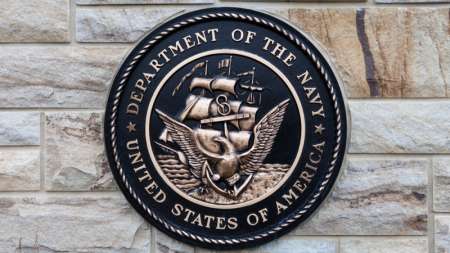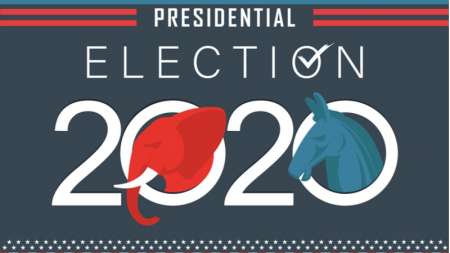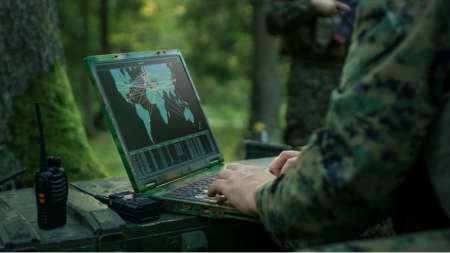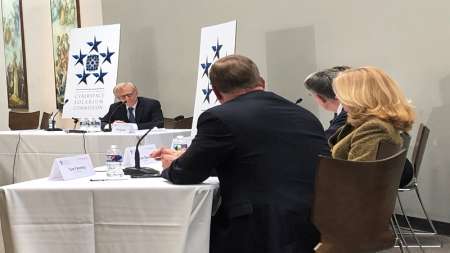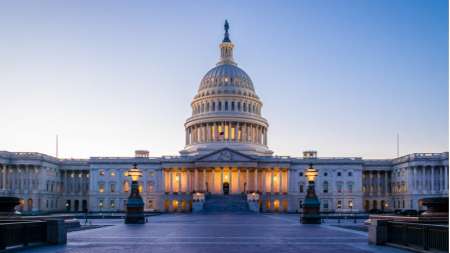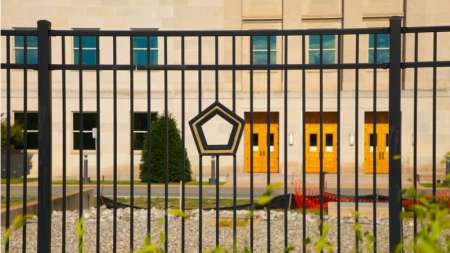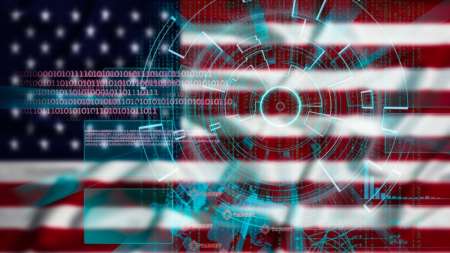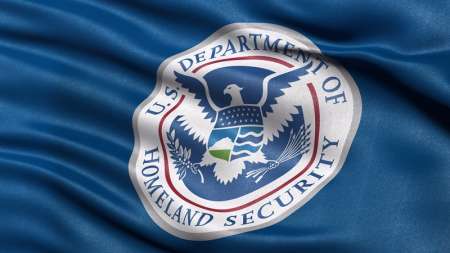U.S. Cyber Command (CYBERCOM) deployed its digital force 22 times on “hunt forward” missions to over a dozen countries in 2023, Lt. Gen. Timothy Haugh – who heads Cyber Command – told lawmakers during a Senate Armed Services Committee hearing on April 10. […]
U.S. Cyber Command (USCYBERCOM) has been awarded a new designation making it an official Federal laboratory and conferring on the command unique privileges to advance the creation of new technologies. […]
The Defense Department (DoD) is in the process of sifting through options to develop the next iteration of the military’s cyber forces, a senior Pentagon official said on Jan. 17. […]
U.S. Marine Corps Maj. Gen. Lorna Mahlock officially took command of the Cyber National Mission Force (CNMF) – the U.S. military’s joint cyber force tasked with defending the U.S. in cyberspace – at a military ceremony on Jan. 5. […]
Gen. Paul Nakasone, who heads both the National Security Agency (NSA) and the U.S. Cyber Command (CYBERCOM), today called for a revamped “CYBERCOM 2.0,” aligning with similar calls from Congress for an independent U.S. Cyber Force. […]
The Pentagon’s Cyber Command (CYBERCOM) foreign cyber threat sharing program is looking to double the number of private sector partnerships it has this year. […]
Officials from the Department of Homeland Security’s (DHS) Cybersecurity and Infrastructure Security Agency (CISA) and the U.S. Cyber Command’s (USCYBERCOM) Cyber National Mission Force (CNMF) revealed this week that collaboration between their agencies was able to prevent two potentially dangerous cyberattacks, including the disruption of an Iranian effort to target election infrastructure. […]
Brig. Gen. Bradley L. Pyburn took over as new Chief of Staff at U.S. Cyber Command on June 9. […]
The Senate on May 26 voted to confirm a pair of Biden administration nominees for top-level military cybersecurity posts. […]
The Department of Defense (DoD) awarded a five-year $979 million contract to Peraton to counter misinformation specifically originating from adversaries of the United States. […]
With the Colonial Pipeline ransomware attack adding to the count of high-profile cyberattacks to make news in the past six months, members of Congress focused in on how the United States can deter such attacks, as well as how to attract talent to the cyber workforce, at a May 14 House Armed Services subcommittee hearing. […]
Dave Frederick Jr. will take over as the Executive Director at U.S. Cyber Command (USCYBERCOM) after serving as deputy director of the organization’s Cybersecurity Directorate in 2019 and 2020. The executive director position at USCYBERCOM is not only the highest ranking civilian position at the Defense Department (DoD) cyber component, but also third-in-command at USCYBERCOM. […]
U.S. Cyber Command has a new Senior Enlisted Leader, who is responsible for advising leadership on military workforce issues and advocating on behalf of military personnel. […]
The Navy’s Fleet Cyber Command/TENTH Fleet – a force of 55 commands and 40 Cyber Mission Force units across the globe – has unveiled its long-range strategic goals for the “21st century’s Information Age.” […]
While the commander of U.S. Cyber Command emphasized action in protecting the elections on July 20, so too did a group of over 30 former government officials in a letter to House and Senate leadership. […]
The Senate’s annual defense bill puts the Secretary of Defense on the hook for a plan on the U.S.’ “cyber hunt forward operations,” a strategy ostensibly outlined by National Security Presidential Memorandum 13, which governs offensive cyber operations and had not been seen by members of congressional defense committees for months after its 2018 adoption. […]
The National Guard and U.S. Cyber Command have formed a partnership to open lines of communication between state and local governments and the military’s top cyber force to address the top priority of the command - the 2020 elections. […]
With the release of the Cyberspace Solarium Commission report, there has been much discussion about the future of cyber policy. A key component of the Trump administration’s current cyber policy, however, has been obscured from Congress for months, until recently. […]
“We didn’t think that we needed to invent a new agency when we got one [CISA] that’s working,” said Solarium co-chair, Sen. Angus King, I-Maine, “But we did think that there was something missing and that was leadership from the top.” […]
Rep. Mike Gallagher, R-Wis., a member of the Cyberspace Solarium Commission that is set to release recommendations March 11 on how to better defend the U.S. against cyber threats, said today the commission hopes to spark quick action by Congress on at least some of those recommendations. […]
U.S. Cyber Command’s Fusion Cell component determined that adversaries would change their tactics based on secret U.S. intelligence information disclosed by former Army analyst Bradley Manning via WikiLeaks in 2010, a recently released document shows. […]
As the U.S. prepares for the 2020 presidential primary’s “Super Tuesday,” officials from the nation’s defense agencies are trying to quell election security concerns. […]
Jim Sullivan, defense intelligence officer (DIO) for cyber at the Defense Intelligence Agency (DIA), emphasized the value of offensive operations in cyberspace to deter nation-state attackers during a panel discussion this week at the RSA security conference in San Francisco. […]
Both the growing ability to project offensive cyber power, and a long list of old friends around the world, are helping the Federal government to develop a greater ability to create more effective deterrence against cyber adversaries, a senior Defense Department (DoD) official said on Feb. 26. […]
White-hat hackers have scooped up $33,750 through Hack the Proxy, the eighth hacker-focused cyber challenge created through a partnership between the Defense Department (DoD) and HackerOne. […]
Army Gen. Paul Nakasone – who heads both the National Security Agency and U.S. Cyber Command – said today that the first focus of NSA’s recently launched Cybersecurity Directorate will be to shore up protection of companies that make up the nation’s Defense Industrial Base (DIB), and specifically to prevent the theft of intellectual property from DIB companies. […]
U.S. Cyber Command is learning from a host of challenges including maneuvering through congested information environments to combat adversaries, said Gen. Richard Angle, Cyber Command’s Deputy Commanding General (Operations), at AUSA’s ILW Hot Topics event today. […]
In defending the integrity of election security for 2018, U.S. Cyber Command used 2016 as a framework to thoroughly understand adversaries in the cyber domain. […]
The United States continues efforts to improve election security and cybersecurity posture, but adversarial threats are still present and evolving, experts agree. […]
In a statement on the recent reports of Iranian cyberattacks directed at the U.S. government, the Department of Homeland Security’s (DHS) Cybersecurity and Infrastructure Security Agency (CISA) Director Christopher Krebs warned of “wiper” attacks that could compromise entire systems. […]

